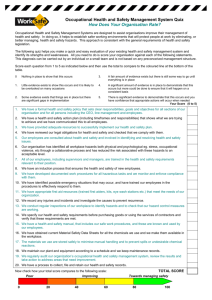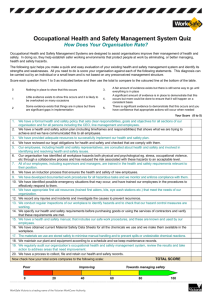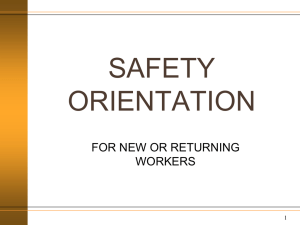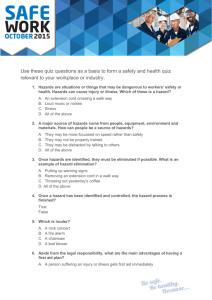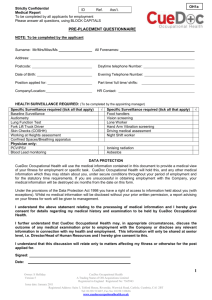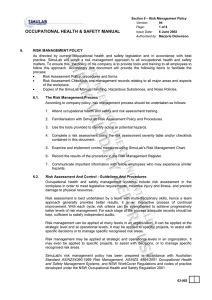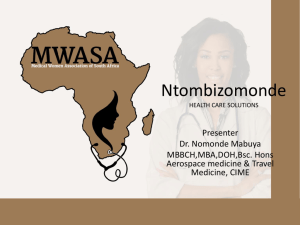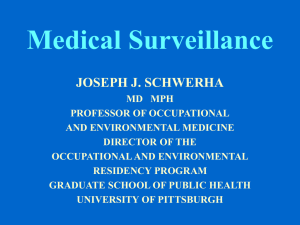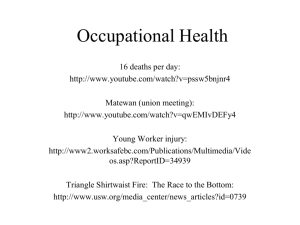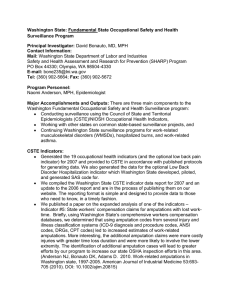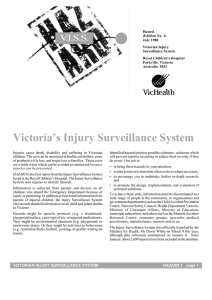Introduction to Occupational Safety and Health
advertisement
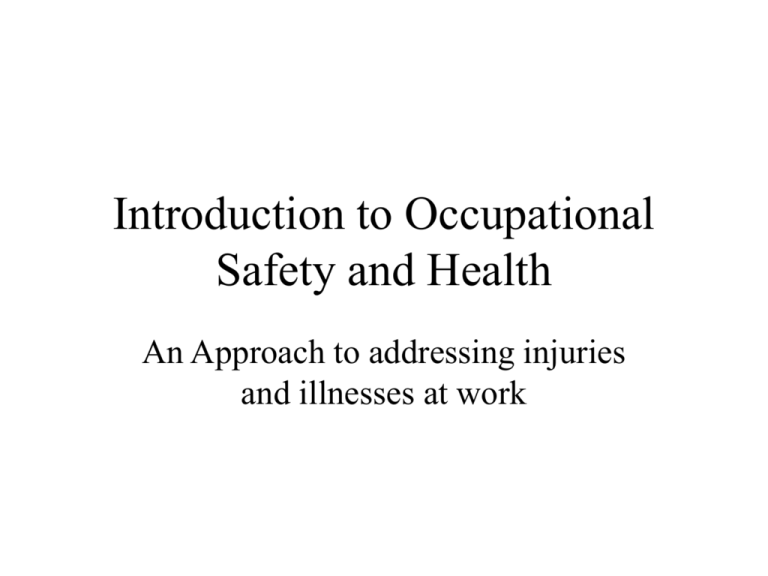
Introduction to Occupational Safety and Health An Approach to addressing injuries and illnesses at work Global Burden of Occupational Injury and Disease/Year Injuries Diseases Total Fatal 100,000 700,000 800,000 Non-Fatal 99,000,000 10,300,000 109,300,000 100,000,000 11,000,000 111,000,000 *From Leigh, et al., Epidemiology 10(5):626-31, September 1999 *Estimated Annual Incidence of Occ Injury & Disease Worldwide # New Cases/year Injuries 100,688,000 Diseases Pesticide poisoning 109,000 Other poisoning 122,000 Cancer 191,000 Mental disorders 318,000 Pneumoconioses 453,000 Noise-induced hearing loss 1,628,000 Skin disorders 1,895,000 Chronic respiratory disease 2,631,000 Musculoskeletal disorders 3,337,000 Global Burden Non-fatal Occ Illness & Injury, WHO SKIN NON-FATAL OCCUPATIONAL INJURY DUST/LUNG 12% 12% 1% 4% 1% 4% RESP TOX POISONING 66% TRAUMATIC INJURY PHYSICAL AGENTS Primary Prevention • Identify and eliminate hazards • Systems to protect workers health and safety • Eliminate and reduce exposure Secondary and Tertiary Prevention • first aid • treatment • emergency services Introduction to Occupational Safety and Health • Identification – recognition – assessment • Control – eliminate – manage – personal protection • Prevention Framework Framework • Awareness • Qualitative Assessment – Exposure – Health • Hazard Judgment – Acceptable – Unacceptable – Uncertain • Quantitative Assessment – Exposure – Health • Risk communication Interventions Engineering Administrative Framework • Awareness of Exposure Hazard – Sentinel Event – Observations • personal • newspaper • reports – Complaints – Near misses Framework • Qualitative Assessment – Exposure assessment • epidemiology • reports • historical data – Health assessment • toxicology • surveillance reports • historical data Framework • Exposure Profile and Hazard Judgement Where do I begin????? – Acceptable --Unacceptable --Uncertain Framework • Hazard Judgement----uncertain – quantitative health assessment • medical surveillance • health surveys – quantitative exposure assessment • personal monitoring • workplace/environmental monitoring • exposure surveys Framework • Risk communication – principles of risk communication – policy Resources • • • • Training Internet – World Health Organization – International Labour Organization – Other Local Expertise – scientists – physicians – nurses – public health practitioners – health educators Reference Materials – journals – ILO encyclopedia Cost of injuries and illnesses to employers • • • • • • • Payment for work not performed Medical payments Reduction or interruption of services Administrative costs Replacing injured or ill worker Training new workers Poor public relations Course Objectives • Recognize a sentinel event as a warning signal that preventive measures need to be taken • Conduct a basic incident investigation • List the occupational hazards in a complex manufacturing workplace • List the adverse health outcomes from exposures in this workplace • Interpret data from a follow-up investigation of this workplace. Course Objectives • Develop a surveillance program that serves as an evaluation tool for health risks in tanneries • Develop a questionnaire surveillance tool for monitoring hazards and adverse health outcomes in industry • Discuss issues related to worker surveillance • Present data in a form that can be understood by employees and policy makers, including employers and local/state enforcement agencies • Apply information gathered from above activities to develop policy recommendations for the tannery industry Skills • • • • • develop incident investigation questions create a report from incident investigation take a work history categorize hazards develop workplace exposure and health questions • organize questions into a surveillance tool • administer a survey • communicate findings of a survey Defining Terms • • • • • • Hazardous Source Hazardous Agent Hazardous Effect Assessment Sentinel Tannery – Complex Manufacturing Process
